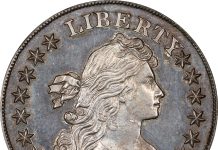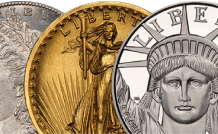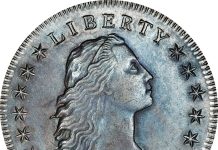From English Kings Harold II, William I and Edward III
BY GREG REYNOLDS
Medieval coins hold great historical importance and tell especially fascinating stories. Some of the most significant British rarities capable of illustrating history were recently sold at auction. These rarities from English Kings Harold II, William I and Edward III, medieval coins that help to chronicle the story of Britain, were included in six landmark auctions at the New York International Numismatic Convention (NYINC) held in January 2025 at the InterContinental Barclay hotel, New York.
Heritage Auctions; Classical Numismatic Group, LLC (CNG); St. James’s Auctions (Stephen Fenton, director); Dmitry Markov Coins & Medals; Stack’s Bowers Galleries and Spink & Son were the auction companies that staged the events that exhibited and offered these extraordinary numismatic artifacts and, by selling these important coins, made history themselves.
Coins of King Harold II Godwinson, William I the Conqueror and Edward III are especially meaningful. These three kings each had an enormous impact on the history of Europe. In terms of coin collecting and monetary history, the gold coins of Edward III were pathbreaking.
King Harold II Godwinson ruled for less than 10 months in 1066, the most important year in the history of the British Isles. Harold II was replaced by King William I the Conqueror. Edward III was King of England for about half a century, from 1327 to 1377.
Earlier, King Athelstan, grandson of Alfred the Great, ruled Southern England from 924 to 927 and England overall from 927 to 939. He held together a network of former Anglo-Saxon kingdoms. Moreover, Athelstan’s armies and allies defeated Viking strongholds and independent Scandinavian societies in England. His takeover in 927 of a Viking-founded society based in York was a landmark event.
Nearly all Vikings originated in Scandinavia. For a long period of time, Vikings controlled York and some other cities in the British Isles, so Athelstan’s victories over them were monumental. King Athelstan’s forces also successfully invaded Scotland and his reach extended into other parts of the British Isles. Until 1066, however, the Anglo-Saxons of England continued to battle Vikings.
On January 5, 1066, King Harold II Godwinson ascended to the throne of England. In September 1066, his forces defeated the armies of King Hardrada (Harald Sigurdsson) of Norway and local allies in battles in central and northern England. The Vikings were finally stopped and it appeared as though centuries of warfare had come to an end.
The unity and peace achieved in September 1066 were short-lived. Within a few weeks, the Normans invaded England. British forces were exhausted after defeating the forces of King Hardrada (Harald Sigurdsson) and other Vikings. They were not prepared to handle a large-scale invasion from Normandy. For the most part, the Normans inhabited a section of northern France, though the historical boundaries of Normandy are unclear to historians. Normandy was then an independent country.
In October 1066, the Normans took control of England. King Harold II Godwinson was killed in battle by the Normans. William the Conqueror, who was then the Duke of Normandy, became King William I of England.
William the Conqueror was a direct descendant of a famous Viking leader, Earl Rollo, who had become the first Duke of Normandy, probably around 912, by way of a treaty with French King Charles III. By 1066, the Normans were largely a mix of Scandinavians and people from Western France, though Belgians were included as well. The Normans spoke a variation of French and later influenced the development of the English language.
SILVER PENNY
There were coin denominations common to the diverse ethnic groups and political factions in Northern and Western Europe. Before the 1200s, the main coin denomination in much of the British Isles and in many European societies was the ‘silver penny.’ The term ‘penny’ had a meaning in medieval times that is much different from its meaning after 1700 and is unrelated to the meaning of a ‘penny’ in the United States, which is a small one-cent coin. In many medieval societies in Europe, the silver penny was the most widely used coin denomination.
To understand the use of silver coins in the past it is important to keep in mind that 480 grains equal one Troy ounce. A U.S. ‘Silver Eagle’ bullion coin, a type that has been minted from 1986 to the present, contains exactly one Troy ounce of silver. Presently, Canada, Australia and many European countries also mint silver bullion coins that each contain one Troy ounce of silver.
At some point before the year 1000, a silver penny was specified to weigh 24 grains of silver, 1/20 (5%) of a Troy ounce. At times, the weight of a penny was reduced to 20 grains, 1/24 of a Troy ounce, but the 24-grain weight standard stood the test of time. Even now, a “pennyweight” (dwt) of 24 grains remains a standard in the jewelry industry.
The notion of 240 pennies (or pence) amounting to a monetary “pound” stems from a coinage system introduced by Charlemagne of the Franks in the 790s. Emperor Charlemagne is also known as ‘Charles the Great’ and French King Charles I.
On Jan. 15, at the convention, CNG auctioned a raw gold coin of Charlemagne, which the cataloguer said grades ‘Near Very Fine,’ for $30,625. Although this is a coin struck in his name in Italy shortly after his conquest of the Lombardic Kingdom in 774, French King Charles I was not then called Emperor Charlemagne. He was crowned as the Holy Roman Emperor by Pope Leo III in 800. Any coin that includes a portrait of Charlemagne is now extremely rare.
It is also significant that this Charlemagne gold coin is a product of the Lucca Mint, which produced coins for nearly 1,200 years. There is presently a Lucca Mint Museum in Italy.
The Carolingian monetary system introduced by Charlemagne was based on the 1:20:240 formula, one pound equals 20 shillings and 20 shillings equal 240 pennies (or pence). Twelve pennies (or pence) amounts to one shilling. Again, it is important to keep in mind that the medieval concept of a penny, where 12 pence equal one shilling, is different from modern terminology. There are equivalent Latin, French and German terms for penny, shilling and pound, which were widely used in medieval times.
Charlemagne’s empire was vast, though it would be hard to explain now, as territorial boundaries were not the same in 800 as they are in 2025. In regard to coin denominations and monetary systems, many societies in Europe followed Charlemagne’s lead, mostly to facilitate international trade. During his lifetime, Charlemagne communicated with King Offa of Mercia, an old Anglo-Saxon kingdom that included London, in regard to coins and international trade.
Charlemagne’s regime influenced the British Isles and much of Northern Europe in addition to his base in Western and Central Europe. It may be fair to credit Emperor Charlemagne with the wide scale minting and acceptance of silver pennies throughout Europe.
SILVER PENNIES AUCTIONED
There were silver pennies of Harold II Godwinson and William the Conqueror in the auctions at the convention in January 2025. As a group, these were impressive.
On Jan. 13, Heritage auctioned an NGC-graded MS-61 “silver penny” of Harold II for $12,000. Heritage reports having auctioned this exact same coin on Aug. 25, 2022, for $9,000. It was in the same NGC holder in 2022 as it was in 2025.
Numismatic Guaranty Company (NGC) in Sarasota, Florida, and the Professional Coin Grading Service (PCGS) in Irvine, California, are coin grading and certification services that also grade coins from around the world. CAC Grading, LLC in Virginia Beach does not yet grade vintage world coins but expects to do so within the next 18 months.
Coins are graded on a scale from one through 70, where grades from 60 to 70 refer to uncirculated or Proof coins, which usually do not have wear apparent under 5x magnification. As far as I know, there were no Proof coins in medieval times, years 500 to 1500 or so.
This NGC-graded MS-61 in this Heritage auction was an exemplary representative of a Harold II silver penny. This coin is clearly uncirculated and it has appealing natural toning. The portrait of the king is clear. Most of the letters are bold and almost all of them are readable. The Roman number II is unmistakable. There are no annoying contact marks.
On Jan. 18 at the convention, Stack’s Bowers auctioned two Harold II silver pennies. Although the names of applicable mint officials are cited on many silver pennies of England, I am ignoring them here. Very few collectors focus upon such names.
Stack’s Bowers auctioned an NGC-graded MS-61 Harold II silver penny for $6,600. The already cited NGC-graded MS-61 Harold II silver penny sold by Heritage during the same week for $12,000 was much more appealing.
Two coins of the same design type that were struck in the same year at the same mint may receive the same numerical grade from the same grading service yet be very different. Eye appeal, scratches, marks from contact from other coins, toning, centering, detail when struck and other aspects vary from coin to coin. It does not make sense to judge a coin by its holder from a certification service.
The second Harold II silver penny auctioned by Stack’s Bowers at the convention was PCGS-graded AU-55 and was struck at the Winchester Mint in Southern England. It went for $5,040, a strong price for this specific coin. Again, coins really need to be held to be understood.
On Jan. 19, Spink auctioned an uncertified Harold II silver penny, which was struck at the Lincoln Mint. Though graded “Very Fine” in the Spink catalogue, it would be graded significantly higher by some experts in the United States. This coin realized $5,760.
WILLIAM THE CONQUEROR
In October 1066, Norman Duke William the Conqueror was the winner and English King Harold II lost. In medieval times, Normandy played a large historical role, though it has since been thought of as just a region in France. Political boundaries changed over time.
William I the Conqueror was king of England from 1066 to 1087. On Jan. 19 at the convention, Spink auctioned five silver pennies of William the Conqueror. These five vary tremendously in color, eye appeal, surface quality, detail of strike and other aspects. Prices realized ranged from $420 to $1,080.
Silver pennies of William the Conqueror do not cost a fortune. Thousands of rare U.S. silver coins cost more than $1,080 each.
On Jan. 18, Stack’s Bowers auctioned a standout William the Conqueror (S-1251) silver penny for $2,160. Coins from the British Isles are often referenced by (S-) index numbers in the “Standard Catalogue,” a multi-volume guide that is currently published by Sovereign Rarities in London.
It is important to note that “catalogue” is spelled with a “u” and an “e’’ in Great Britain. Until the 21st century, most coin auction firms in the United States employed this spelling as well in regard to their own auction catalogues. The traditional spelling with a “u” and an “e’’ is appropriate for writings relating to rare coins.
This (S-1251) William the Conqueror silver penny was struck around 1069 at the Wallingford Mint and was NGC-graded as AU-58. I really like this coin, which has very appealing natural colors, especially brown-russet and tan-gray shades, with some blue tints. Possibly a very imperfect region of the reverse brings this coin’s grade down. If two small areas of the reverse had more integrity, this coin would have merited a grade higher than 58, in my opinion. On the whole, though, it would fit very nicely in an exceptional set of silver pennies from the British Isles.
That same evening, Stack’s Bowers then auctioned two more William the Conqueror silver pennies: an NGC-graded MS-62 coin for $1,320 and an NGC-graded AU-58 coin for $1,680. Both of these were struck at the Winchester Mint in Southern England during the 1080s and are of the S-1257 variety in the Standard Catalogue of British coins. These were struck under the supervision of different mint officials, though the names of the “moneyers,” assayer and/or supervisors probably did not have a significant effect on the prices realized of these two William the Conqueror silver pennies.
These two silver pennies really should be seen in reality to meaningfully reflect upon the differences in prices realized. The NGC-graded AU-58 coin, which realized $1,680, has much more detail and more attractive toning than the NGC-graded MS-62 coin, which realized $1,320.
On Jan. 15, CNG auctioned a William the Conqueror silver penny that was struck in the early 1080s at the Bristol Mint. I did not see this coin, which was uncertified and catalogued as grading “Very Fine.” It realized $2,082.50.
The fall of Harold II and the rise of William the Conqueror in 1066 led to a change in the definition of England. The Anglo-Saxon kings and kingdoms were gone. The civil wars within England between Anglo- Saxons and Scandinavians were over. Close connections to Normandy and aspects of French culture impacted England.
In 1066, a majority of Normans were descendants or children of Scandinavians. Normandy, however, included substantial numbers of Belgian and French people.
The Normans rapidly dominated the government of England. Already a multi-ethnic nation, England became more diverse after the Norman Conquest. The population was made up of descendants of Saxons or Angles, Scandinavians (including Vikings), Franks (who were descendants of Gauls), Belgians and others. Celts and Gauls have common ancestors.
The British Isles were inhabited by Celtic Britons before the Romans invaded during the first century AD. Gauls and others from areas now known as Italy, France and Spain were parts of the invading Roman forces who occupied the British Isles. The Romans departed during the period from 388 to 415 or so.
From the 400s to 600s, Angles and Saxons arrived in large numbers. They left their homelands and migrated to England. Saxons came from an area north of Hamburg that now overlaps with the northernmost state in the Federal Republic of Germany.
From the 400s to the 600s, Angles and Saxons fought many battles with Celtic Britons. After the Romans departed and later after the Angles and the Saxons established kingdoms in England, Celtic Britons continued to dominate Ireland, Wales and Scotland. Viking incursions and invasions from the 600s to 1066 led to Scandinavians living in many areas in the British Isles.
As Normans integrated after 1066, England became more powerful and more diverse than it was before. This conquest was a major turning point in history.
EDWARD III AND GOLD COINS FOR TRADE
The reign of King Edward III, which lasted from 1327 to 1377, was a turning point too. In the context of the historical importance of coins in general issued under the reign of each British monarch, the most significant coins after those of William the Conqueror were the gold coins of King Edward III.
Small gold coins minted in England circulated briefly during the late 1250s under the reign of Henry III and some gold coins were earlier minted in the British Isles during Ancient times, before the year 500. Relatively large gold coins that widely circulated were not minted in the British Isles until the 1340s.
The first wave of sizable gold coins, the Leopard series of 1343-44, was a failure. The Double Leopard, Single Leopard and Half-Leopard of 1343-44 were inconsistent with the monetary order of the time period.
Shortly after the Leopard series of gold coins were canceled, the government of Edward III introduced the Noble, Half-Noble and Quarter- Noble. A Noble was denominated as six shillings, eight pence (pennies), thus 80 pence in total, precisely one-third of a British Pound and exactly one-half of a “mark,” which was a unit of account used in many contexts in the British Isles and elsewhere. Although no Edward III coins were denominated in marks, the mark was widely used by residents of the British Isles who had Scandinavian parents or ancestors. It is likely that this “mark” was also used as a unit of account in some German states.
It was economically efficient for the government of Edward III to mint coins that were easily understood in marks as well as in British Pounds. As they were used throughout much of Europe and parts of Asia, the Edward III Noble coin denominations were symbols of England becoming an international economic power.
At first, a Noble contained about 0.288 Troy ounce of gold. The intention was probably for each shilling (sum of 12 pence) to contain 21 grains of gold. This gold standard was soon reduced. Each Noble of the 1351 to ’61 pre-treaty period was struck under the logical weight standard of 120 grains, one-fourth of a Troy ounce of gold, a convenient measure that was widely understood and still is so.
On Jan. 13 at the convention, Heritage auctioned an NGC-graded MS-62 (S-1484) Noble, which was struck in 1351 or 1352 at the Tower Mint in London. I have examined dozens, possibly hundreds, of Edward III Nobles, and this is one of the more appealing. Yes, it has some surface imperfections. Even so, it is well struck on a better than usual blank. Its color is attractive. Most Edward III Nobles known now were “found in the ground,” and were conserved after being unearthed. This one was less conserved than usual. It is a coin that I would recommend. The $12,000 price realized was strong, though very much understandable.
The next lot brought 50% more: $18,000. It was an NGC-graded MS-64 (S-1490) Noble that was struck between 1356 and 1361, also at the Tower Mint in London. The just-mentioned NGC-graded MS-62 (S-1484) Noble was a much better value, in my opinion.
On Jan. 15, CNG auctioned an uncertified (S-1500) Edward III Half- Noble, which the CNG catalogue says was struck in 1361, for $2,450. I did not see this coin. It was catalogued as grading “Very Fine.”
On Jan. 18, Stack’s Bowers auctioned an NGC-graded MS-64 Edward III Half-Noble (S-1506), which was struck in London during the 1361 to ’69 treaty period. This is an attractive coin with quite a few imperfections. The reverse is of much higher quality than the obverse. It is not as appealing as some other Half-Nobles and also Nobles that have been NGC-graded MS-64. The $6,600 price realized was certainly fair.
Also on Jan. 18, Stack’s Bowers auctioned an NGC-graded MS-62, Edward III Noble (S-1503), which was minted in London between 1361 and 1369, the treaty period. Although this Noble has some noticeable imperfections on the borders and edge, which is not unusual for medieval gold coins, the centers on both sides have almost no imperfections and are really exceptional. Though conserved and lightly cleaned in the past, this coin has much orange natural retoning, which is entertaining. Overall, this Edward III Noble is strictly uncirculated and attractive. The $10,800 price realized was a very good value.
Edward III Nobles and other medieval coins of immense historical importance were among a large number of attractions at the convention in January. These represent some of the many exciting options for collectors willing to explore new realms.
Attractive and historically important medieval coins often cost a lot less than many of the rare gold and scarce silver British or U.S. coins that were minted from 1800 to 1950. While buying truly rare coins, collectors may enjoy learning about very important events in the history of the world.
Greg Reynolds, named to COINage’s “Greatest Coin Graders in the World” list, is an independent rare coin consultant who is available for assistance with auctions, private sales and market analysis. Reynolds has written more than 800 published articles relating to coins, patterns or medals, and many private reports for clients.
Reynolds’ articles have appeared in nine different coin publications. Over the past five years, he has contributed more than 100 articles to the Whitman- CDN-Greysheet family of publications and many more to the CAC website (cacgrading.com). Since 2012, Reynolds has received outright or shared at least twenty-four awards from the Numismatic Literary Guild (nlgonline.org), including awards for articles or analytical series on U.S. coins, American medals, British coins, epic collections, collecting strategies and historical aspects of coins.
Reynolds has attended dozens of major auctions, including sales of several of the all-time greatest collections, and has spent hundreds of hours carefully viewing auction lots. Indeed, he has carefully examined a substantial percentage of the choice and rare U.S. coins in existence and a large number of condition rarities. Reynolds has also viewed thousands of vintage British coins and numerous Latin American rarities. Email Insightful10@gmail.com.












